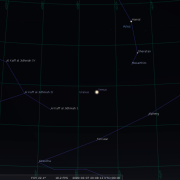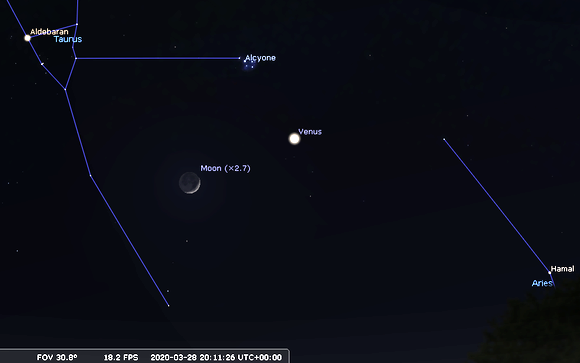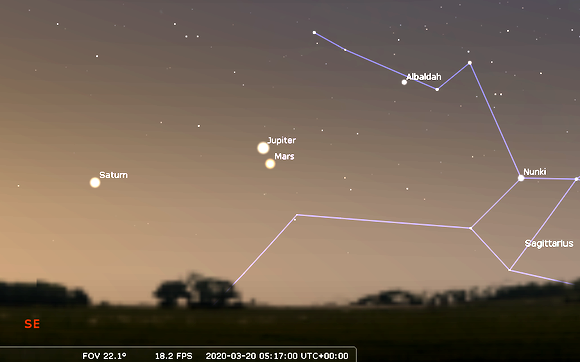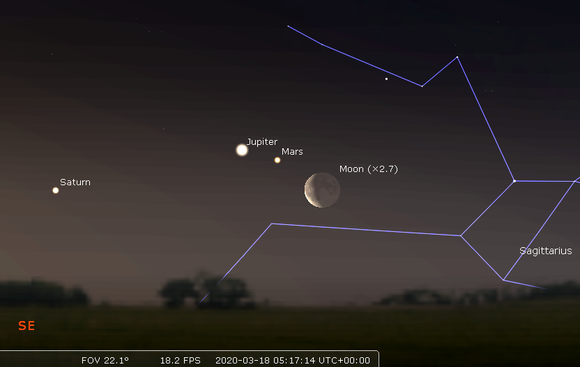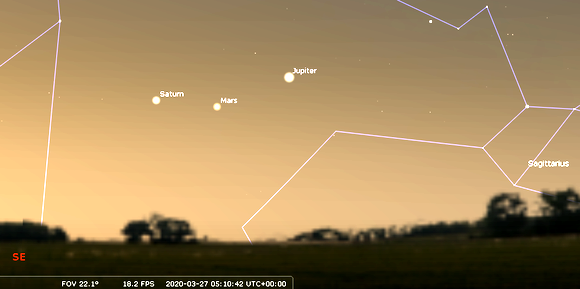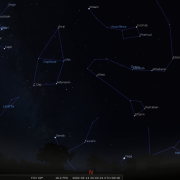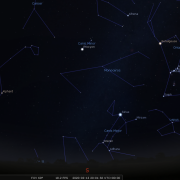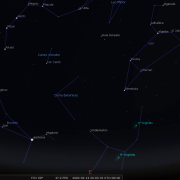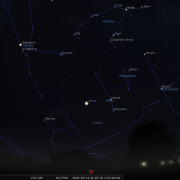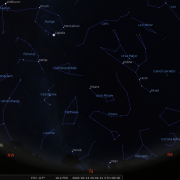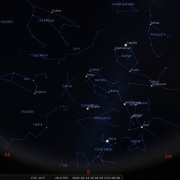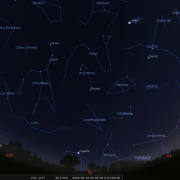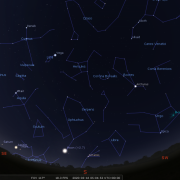In this month's Sky Notes:
Planetary Skylights
Evening Planets
Venus rules in the evening sky, whilst Mars, Jupiter and Saturn vie for attention in the dawn sky.
 Venus is totally dominant in the evening sky, not setting until almost midnight by the end of March (after BST commences) If you want to view Venus satisfactorily through the ‘eyepiece’, try to observe in bright twilight and not when fully dark, by which time it is rather too dazzling.
Venus is totally dominant in the evening sky, not setting until almost midnight by the end of March (after BST commences) If you want to view Venus satisfactorily through the ‘eyepiece’, try to observe in bright twilight and not when fully dark, by which time it is rather too dazzling.
You will at least discern the phase (a half phase) and perhaps some subtle darker markings in the clouds. The surface is perpetually hidden under the thick cloud duvet that traps nearly all the heat in, making the surface of Venus the hottest of any planet.
As Venus continues to move up through Pisces and into Aries, it passes Uranus on the 7th approximately 2 degrees to the left of Venus. You will require binoculars to spot fainter Uranus and a telescope to reveal the tiny disk.
 The crescent Moon joins Venus on the 28th which has moved up below the lovely Pleiades star cluster making for a pretty picture indeed. Next month Venus ploughs right through the Seven Sisters.
The crescent Moon joins Venus on the 28th which has moved up below the lovely Pleiades star cluster making for a pretty picture indeed. Next month Venus ploughs right through the Seven Sisters.
 Uranus resides in Aries, which is slipping down towards the West horizon, passing Venus on the way up on the 7th and 8th. Although technically visible to the naked eye at mag +5.9, in reality binoculars, or better still, a telescope are required to spot it. Uranus resides just within the borders of Aries approximately 4 degrees below the ‘crooked line’ asterism of the Ram. If you have a constellation chart or App etc, use Mesarthim and iota Aries as pointers to locate Uranus, which resides roughly 3 times the distance between these stars and a tad to the right, below them. Through a telescope Uranus resembles a very small disk of subtle grey/green hue.
Uranus resides in Aries, which is slipping down towards the West horizon, passing Venus on the way up on the 7th and 8th. Although technically visible to the naked eye at mag +5.9, in reality binoculars, or better still, a telescope are required to spot it. Uranus resides just within the borders of Aries approximately 4 degrees below the ‘crooked line’ asterism of the Ram. If you have a constellation chart or App etc, use Mesarthim and iota Aries as pointers to locate Uranus, which resides roughly 3 times the distance between these stars and a tad to the right, below them. Through a telescope Uranus resembles a very small disk of subtle grey/green hue.
Dawn Planets
Much of the planetary action occurs in the dawn sky, where Mars, Jupiter and Saturn all reside. A clear uncluttered horizon will make things easier for identification. As March progresses look for ‘ruddy’ Mars rapidly closing in on much more conspicuous Jupiter.
 Mars is currently only as bright as an average first magnitude star (Mag +1.25). Mars and Jupiter are closest on the 20th, separated by just over half a degree. View around 05:00-5:30h.
Mars is currently only as bright as an average first magnitude star (Mag +1.25). Mars and Jupiter are closest on the 20th, separated by just over half a degree. View around 05:00-5:30h.
18-Mar-2020 at 05:15h (SE): Dawn planets Jupiter, Mars and Saturn with a Crescent Moon.
(Click for full-sized image)
 The red planet then closes in on Saturn passing below the ringed planet on the last day of the month. Saturn is also brighter than Mars, which in the eyepiece appears disappointingly small to yield meaningful views, unless you have serious ‘instrumentation’.
The red planet then closes in on Saturn passing below the ringed planet on the last day of the month. Saturn is also brighter than Mars, which in the eyepiece appears disappointingly small to yield meaningful views, unless you have serious ‘instrumentation’.
 Jupiter and Saturn do however have something to offer, whether it’s the rings of Saturn, or the cloud belts and major moons of Jupiter. Just be aware that the low altitude will effect observations, what astronomers refer to as ‘seeing’ will be challenging for the time being.
Jupiter and Saturn do however have something to offer, whether it’s the rings of Saturn, or the cloud belts and major moons of Jupiter. Just be aware that the low altitude will effect observations, what astronomers refer to as ‘seeing’ will be challenging for the time being.
The waning Moon passes just beneath the dawn planets on the 18th and 19th.
Meteors

No major showers this month; however at the very end of March you may spot a few Virginids, which are slow moving and have long paths. As usual early morning hours are best to spot any meteors.
Spring Equinox

The date of the Vernal Equinox and for the northern hemisphere, the start of astronomical spring, falls on March 20th this year. On this date the Sun's path on the ecliptic crosses the celestial equator on its apparent journey northwards into the sky. The orientation of the Earth at the spring or autumnal equinox is such that neither of Earth’s poles is inclined toward the Sun and all locations experience equal hours of daylight and darkness - hence the term equinox.
The Vernal Equinox is also known as the 'First point of Aries', as the Sun used to stand before the constellation of the Ram when it first crossed the celestial equator. Although still called the 'first point of Aries', today its location now resides in Pisces, a consequence of the effect known as precession; the Earth's slow wobble
Over thousands of years our ancestors noted that certain star patterns rose just before the Sun at specific times and were considered significant for this very reason. Subsequently they were able to build a picture of the apparent path of the Sun against these constellations.
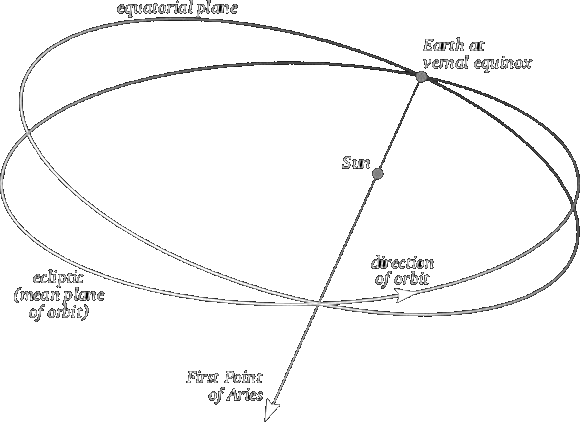
The narrow path upon which occasionally the Sun and Moon would meet giving rise to an eclipse, became known as the Ecliptic. The broader belt along which the 'wandering stars' or planets travelled was known as the Zodiac, so called because all 12 constellations located on it were associated with living creatures.

Zodiac literally means 'Band of Animals'. Libra used to be considered being part of Scopius, the claws to be precise. Ophiuchus, the serpent bearer immediately following Scorpius was instead regarded as a zodiac group. Ever since the stars of Libra were elevated in status, Ophiuchus, being surplus to requirements, was ditched, much to the relief of astrologers. If you find it difficult to remember the order of the zodiac constellations, then the following rhyme may be of use.
The Ram, the Bull, the Heavenly twins
and next the Crab the Lion shines,
The Virgin, and the Scales.
Scorpion, Archer and Sea goat,
The man who pours the water out
and Fish with glittering tails
|
Looking North
Mid-March - 20:00h |
Looking South |
|
Looking East
Mid-March - 20:00h |
Looking West
Mid-March - 20:00h |
|
Northern Aspect
Mid-March - 20:00h |
Southern Aspect
Mid-March - 20:00h |
|
Looking North (Early)
Mid-March - 05:00h |
Looking South (Early)
Mid-March - 05:00h |
Additional Image Credits:
- Planets and Comets where not otherwise mentioned: NASA
- Sky Charts: Stellarium Software
- Spring Equinox images: Wikipedia Commons
- Log in to post comments

